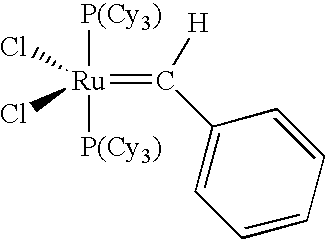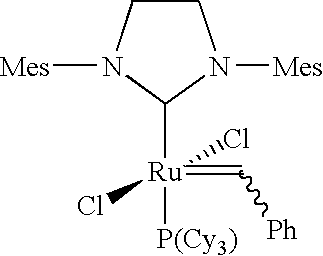Cross-metathesis of olefins directly substituted with an electron-withdrawing group using transition metal carbene catalysts
a transition metal complex and catalyst technology, applied in the direction of organic compound catalysts, group 3/13 element organic compounds, organic compound catalysts/hydrides/coordination complexes, etc., can solve the problems of low thermal stability of compounds, and the difficulty of metathesis reactions with directly functionalized olefins, particularly olefins, to achieve the effect of not significantly compromising the efficiency or selectivity of metathesis reactions
- Summary
- Abstract
- Description
- Claims
- Application Information
AI Technical Summary
Benefits of technology
Problems solved by technology
Method used
Image
Examples
example 1
[0144]Synthesis of (IMesH2)(C5H4BrN)2(Cl2)═CHPh (2):
[0145]Complex 1 ((IMesH2)(PCy3)2(Cl2)═CHPh) (2.0 g), prepared according to literature procedures,
[0146]
was dissolved in toluene (10 mL), and 3-bromopyridine (1.50 grams, 4 mol equivalents) was added. The reaction flask was purged with argon and the reaction mixture was stirred for approximately 12 hours at about 20° C. to about 25° C. during which time a color change from dark purple to light green was observed. The reaction mixture was transferred into 75 mL of cold (about 0° C.) pentane, and a light green solid precipitated. The precipitate was filtered, washed with 4×20 mL of cold pentane, and dried under vacuum to afford (IMesH2)(C5H4BrN)2(Cl)2Ru═CHPh 2 as a light green powder (1.8 grams, 86% yield).
example 2
[0147]Synthesis of (IMesH2)(C6H7N)2(Cl2)═CHPh (3):
[0148]Complex 1 (2.0 grams) was dissolved in toluene (10 mL), and 4-methylpyridine (0.88 grams, 4 mol equivalents) was added. The reaction flask was purged with argon and the reaction mixture was stirred for approximately 12 hours at about 20° C. to about 25° C. during which time a color change from dark purple to light green was observed. The reaction mixture was transferred into 75 mL of cold (about 0° C.) pentane, and a light green solid precipitated. The precipitate was filtered, washed with 4×20 mL of cold pentane, and dried under vacuum to afford (IMesH2)(C6H7N)2Ru═CHPh 3 as a light green powder (1.5 grams, 84% yield).
example 3
[0149]Synthesis of (IMesH2)(C11H9N)2(Cl2)═CHPh (4):
[0150]Complex 1(2.0 grams) was dissolved in toluene (10 mL), and 4-phenylpyridine (1.50 grams, 4 mol equivalents) was added. The reaction flask was purged with argon and the reaction mixture was stirred for approximately 12 hours at about 20° C. to about 25° C. during which time a color change from dark purple to dark green was observed. The reaction mixture was transferred into 75 mL of cold (about 0° C.) pentane, and a dark green solid precipitated. The precipitate was filtered, washed with 4×20 mL of cold pentane, and dried under vacuum to afford (IMesH2)(C11H9N)2(Cl)2Ru═CHPh 4as a dark green powder (2.0 grams, 97% yield).
[0151]1H NMR (500 MHz, CD2Cl2): δ 19.23 (s, 1H, CHPh), 8.74 (br. s, 2H, pyridine), 7.91 (br. s, 2H, pyridine), 7.70−7.08 (multiple peaks, 19H, ortho CH, para CH, meta CH, pyridine), 6.93 (br. S, 2H, Mes CH) 6.79 (br. s, 2H, Mes CH), 4.05 (br. s, 4H, NCH2CH2N), 2.62−2.29 (multiple peaks, 18H, Mes CH3).
PUM
| Property | Measurement | Unit |
|---|---|---|
| Temperature | aaaaa | aaaaa |
| Temperature | aaaaa | aaaaa |
| Temperature | aaaaa | aaaaa |
Abstract
Description
Claims
Application Information
 Login to View More
Login to View More - R&D
- Intellectual Property
- Life Sciences
- Materials
- Tech Scout
- Unparalleled Data Quality
- Higher Quality Content
- 60% Fewer Hallucinations
Browse by: Latest US Patents, China's latest patents, Technical Efficacy Thesaurus, Application Domain, Technology Topic, Popular Technical Reports.
© 2025 PatSnap. All rights reserved.Legal|Privacy policy|Modern Slavery Act Transparency Statement|Sitemap|About US| Contact US: help@patsnap.com



